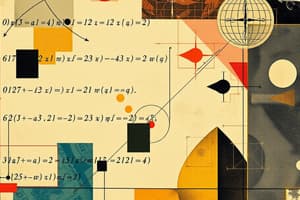Podcast
Questions and Answers
What is the purpose of the elimination method in solving systems of linear equations?
What is the purpose of the elimination method in solving systems of linear equations?
- To divide the equations by a constant
- To add the equations together
- To eliminate one variable from the equations (correct)
- To multiply the equations together
In the system of equations provided, what does eliminating 'x' involve?
In the system of equations provided, what does eliminating 'x' involve?
- Multiplying the first equation by 1/2
- Dividing both equations by 2
- Dividing both equations by 4
- Adding the equations together (correct)
What is the solution for 'y' in the system of equations after using the elimination method?
What is the solution for 'y' in the system of equations after using the elimination method?
- $7$
- $14/3$ (correct)
- $3/2$
- $10/3$
How does fluency with linear equations grow according to the text?
How does fluency with linear equations grow according to the text?
Why is it important to use different approaches when dealing with linear equations?
Why is it important to use different approaches when dealing with linear equations?
In a linear equation of the form $ax + b = c$, what does the variable $x$ represent?
In a linear equation of the form $ax + b = c$, what does the variable $x$ represent?
If a linear equation is given as $2x - 5 = 3$, what would be the correct value for $x$?
If a linear equation is given as $2x - 5 = 3$, what would be the correct value for $x$?
Which method of solving a linear equation involves replacing a variable with its corresponding expression from the opposite side of the equation?
Which method of solving a linear equation involves replacing a variable with its corresponding expression from the opposite side of the equation?
What characteristic of linear equations allows them to express a single variable linearly through other variables and constants?
What characteristic of linear equations allows them to express a single variable linearly through other variables and constants?
If $2y - 7 = y + 3$, what is the correct value for $y$ after solving the linear equation?
If $2y - 7 = y + 3$, what is the correct value for $y$ after solving the linear equation?
Flashcards are hidden until you start studying
Study Notes
Linear Equations: Unraveling Solutions
Linear equations play a fundamental role in mathematics as they model many real-world situations with simplicity and clarity. In this exploration of linear equations, we'll focus particularly on how to solve them—a foundational skill for understanding mathematical relationships.
What Is A Linear Equation?
In its simplest form, a linear equation is expressed as (ax + b = c), where (x) represents a variable, (a), (b), and (c) represent constants, and (a \neq 0). Key characteristics of linear equations are their ability to express a single variable linearly through other variables and constants.
Solving Linear Equations
Solving linear equations involves finding the value(s) of one or more unknown variables when given certain values in the expression. There are multiple techniques to achieve this goal, including:
Direct Substitution Method
This method entails replacing the variable appearing on one side of the equation with its corresponding expression from the opposite side, thereby creating a simpler expression equal to zero. For example: If (y - 8 = x + 1), substituting (x) from the right side into the left side results in (y - 8 = y - 8 + x + 1). Simplifying yields (x = 9), which can then be confirmed by checking if it satisfies both sides of the original equation ((y - 8 = 9 - 8 → y = 1)).
Elimination Method
Also known as the addition property of equality, this technique involves manipulating two expressions concurrently so that one variable is eliminated, thus leaving behind a solved expression involving only the remaining variable. Let's consider the system of equations (2x - 3y = 6) and (x + y = 4): Multiplying the first equation by (\frac{1}{2}) gives us (x - \frac{3}{2}y = 3). Now adding these two transformed equations together eliminates (x), resulting in (\frac{3}{2}y = 7\rightarrow y =\frac{14}{3}). Checking (x+y=4), we find (x=\frac{10}{3}) confirming our solution.
These methods may seem straightforward now; however, mastering problem-solving skills using different approaches is crucial to uncover various aspects of linear equations. As you delve deeper into algebraic concepts like systems of linear equations, graphing lines, and modeling problems with equations, your fluency with linear equations will grow exponentially.
Studying That Suits You
Use AI to generate personalized quizzes and flashcards to suit your learning preferences.




